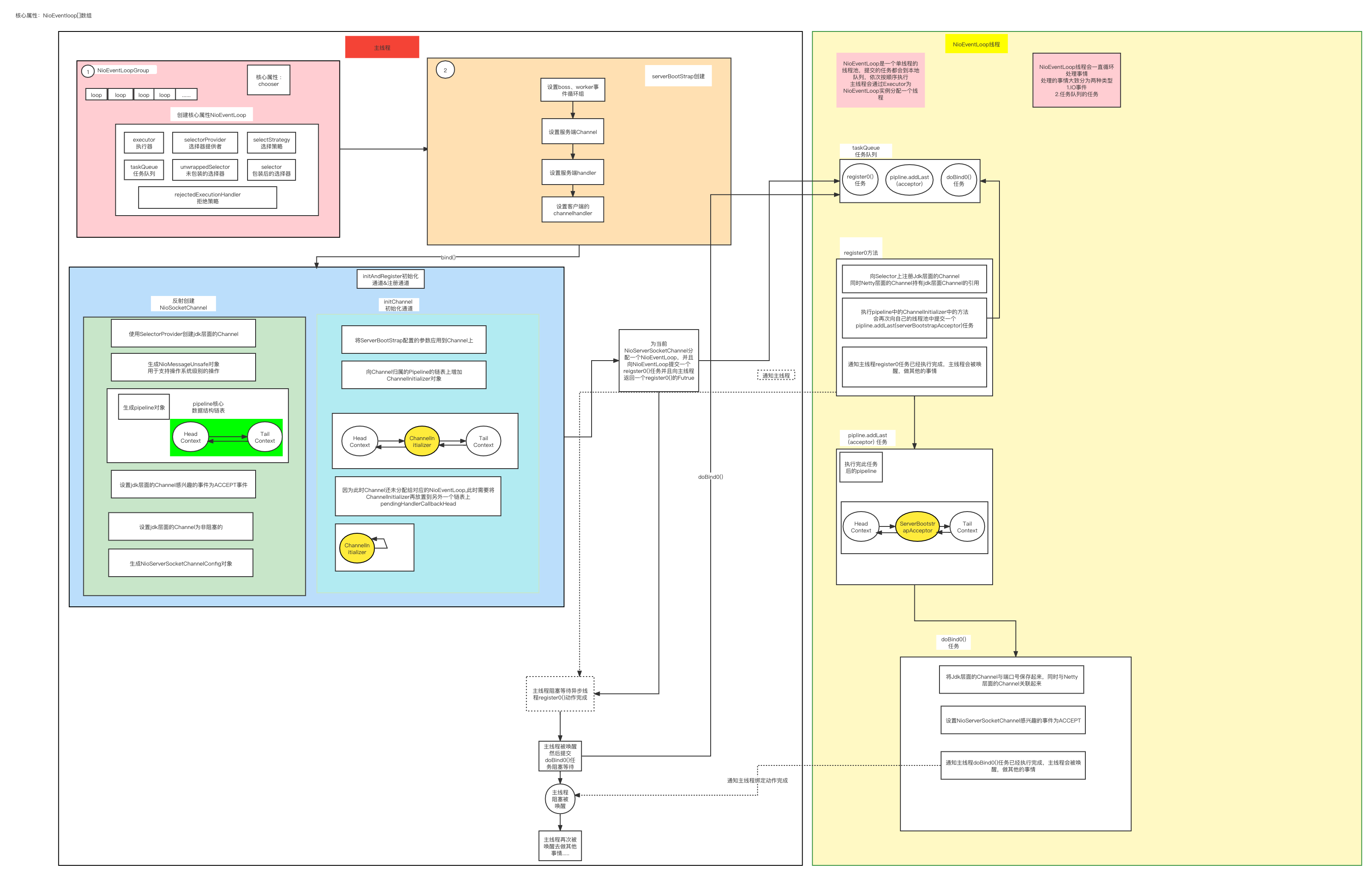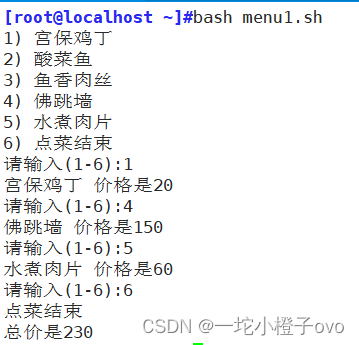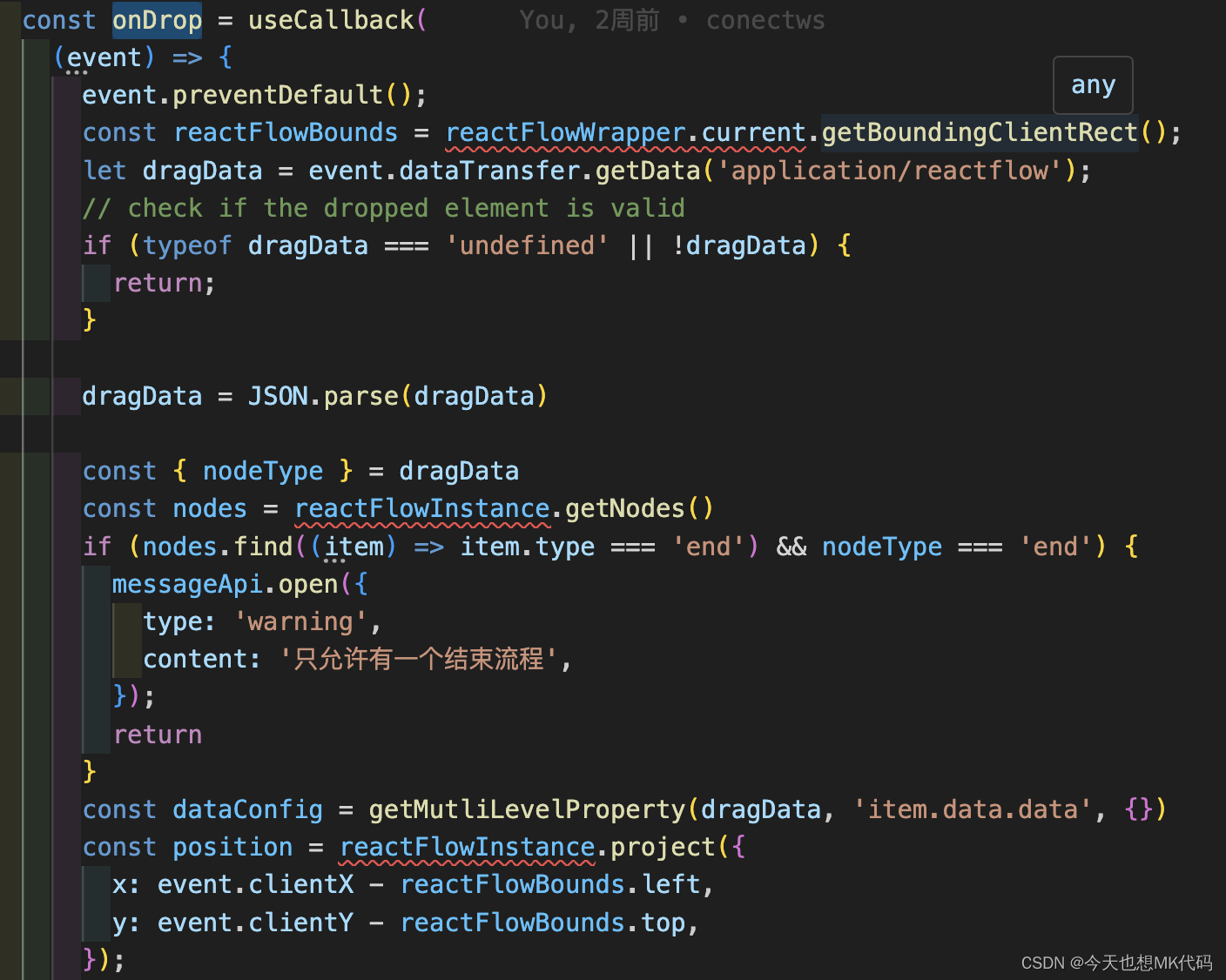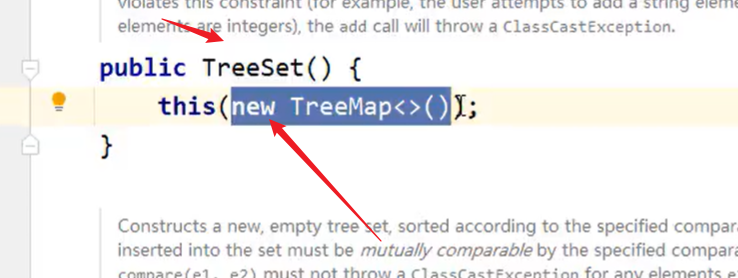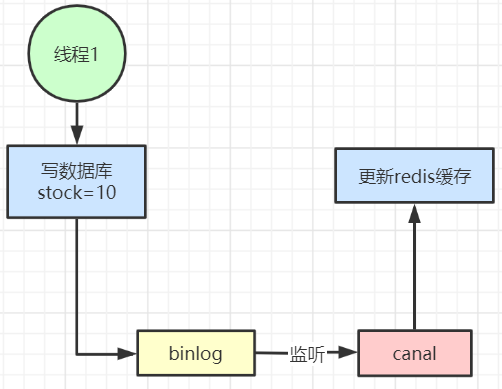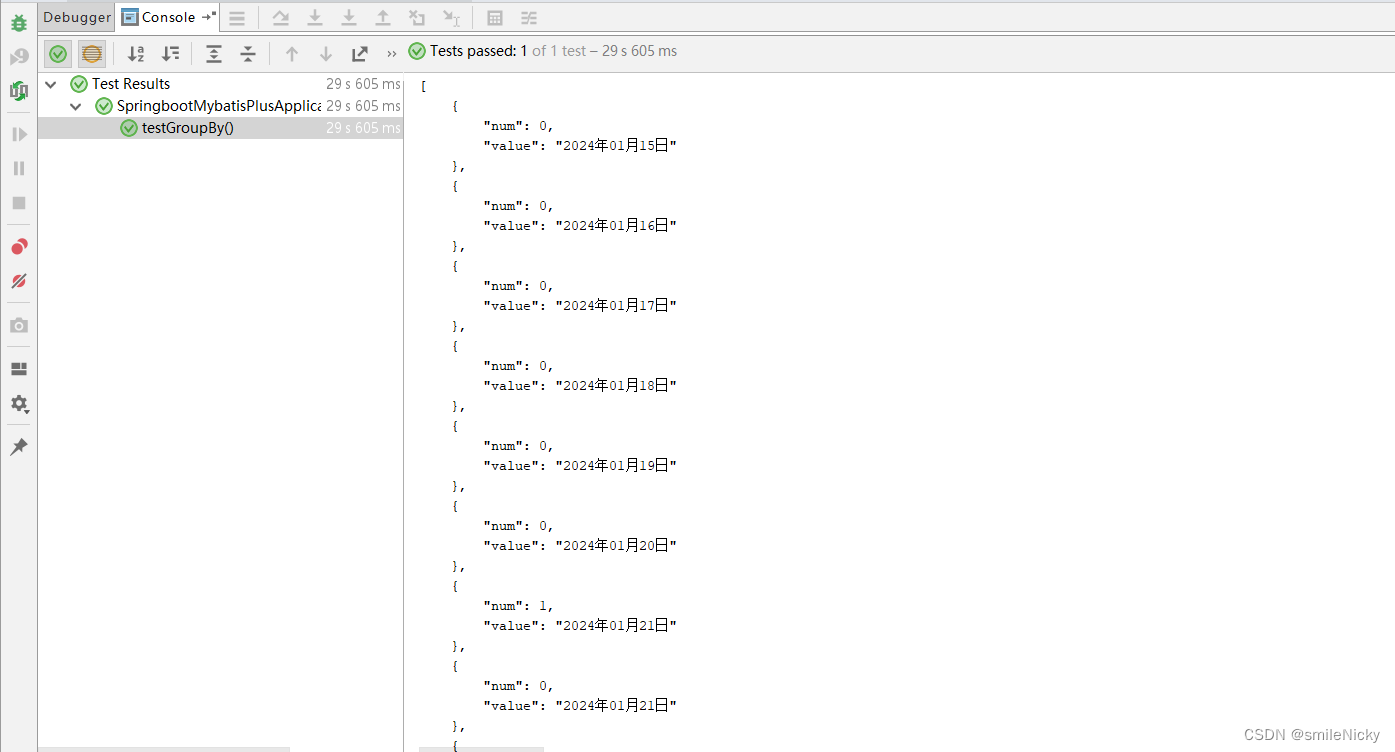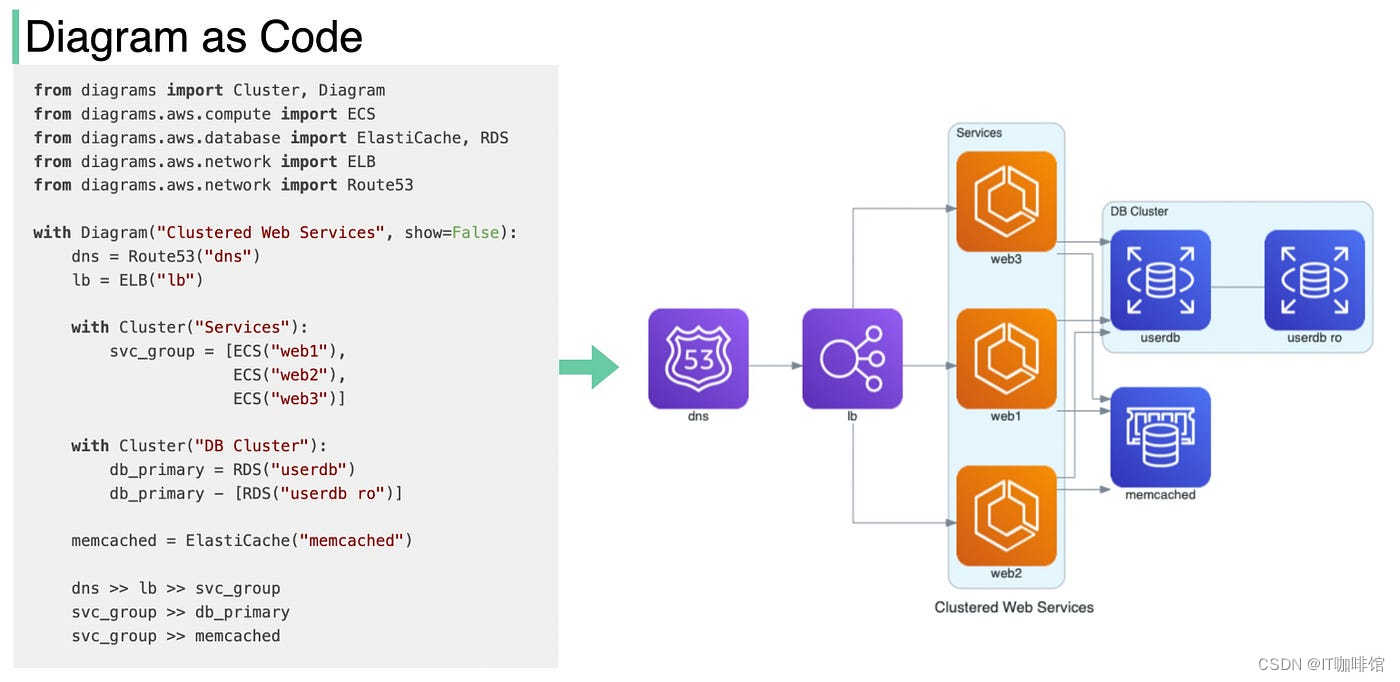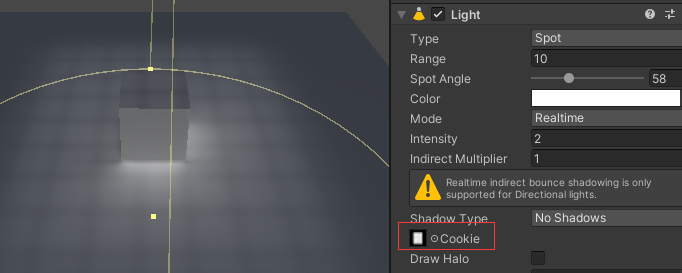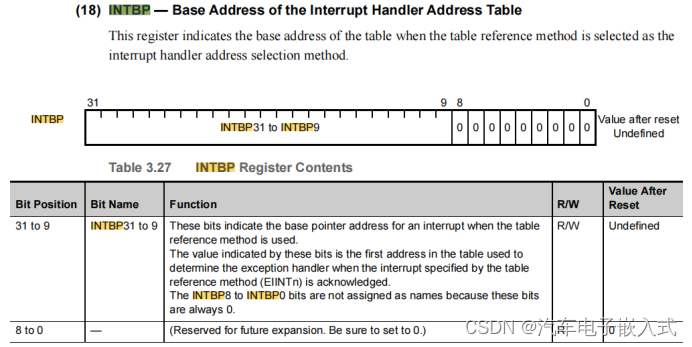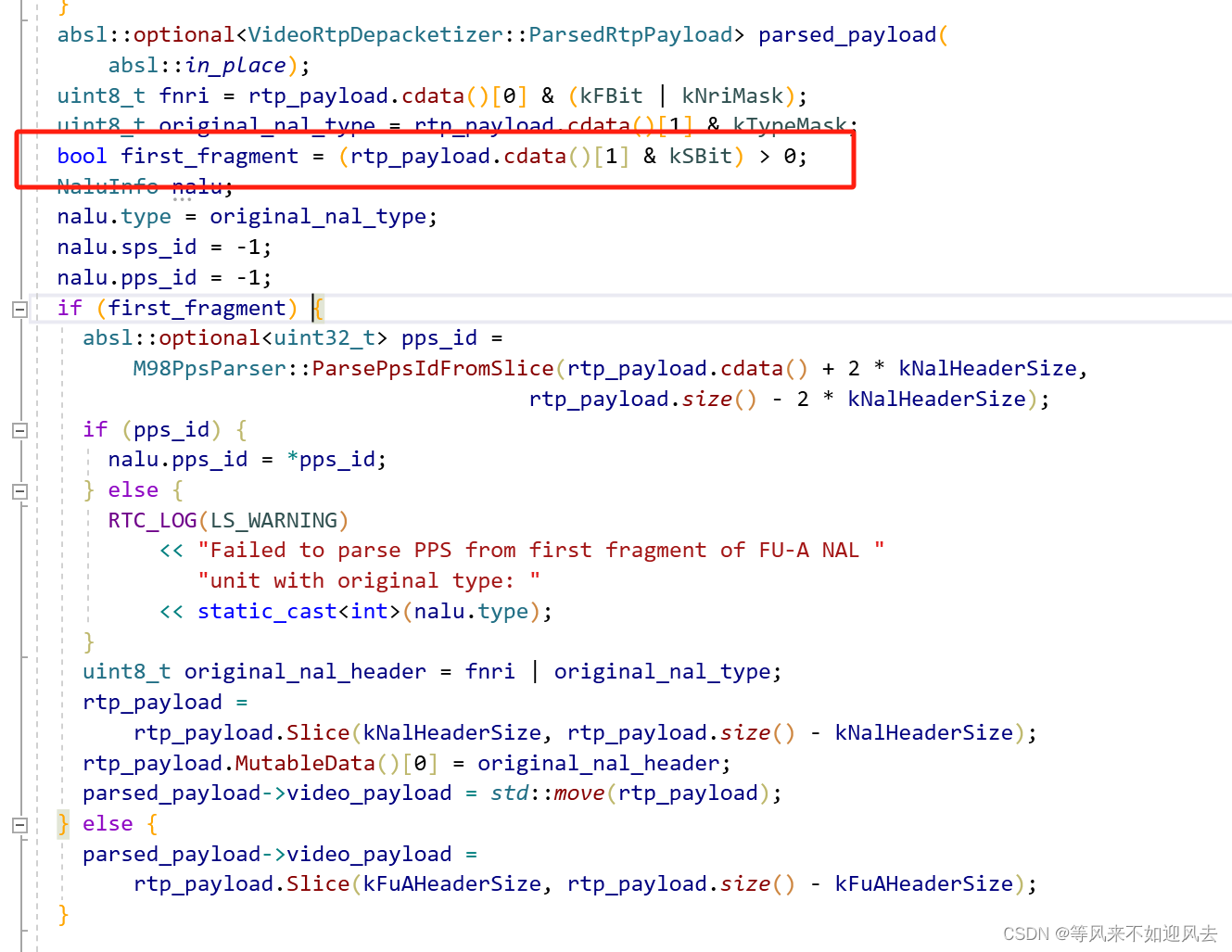示例
public class Server {
public static void main(String[] args) throws InterruptedException {
// todo 创建两个 eventGroup boss 接受客户端的连接, 底层就是一个死循环, 不断的监听事件 处理事件
// new NioEventLoopGroup(1); todo 入参1 表示设置boss设置为1个线程, 默认 = 计算机的 核数*2
EventLoopGroup bossGroup = new NioEventLoopGroup(1);
// todo worker处理客户端的请求
EventLoopGroup workerGroup = new NioEventLoopGroup();
try {
// todo 创建NettyServer的启动辅助类
ServerBootstrap serverBootstrap = new ServerBootstrap();
serverBootstrap
// todo 到目前为止,group()就是把 上面创建的两个 事件循环组一个给了父类(AbstractBootStrap),一个给了自己
.group(bossGroup, workerGroup)
// todo 在每个netty服务器启动的时候,都会执行这个方法 ,接收了 NioServerSocketChannel.class 去反射;
// todo channel 是它父类的方法
// todo 到目前为止仍然是赋值的操作, 把它赋值给 ServerBootstrap的父类 AbstractServerBootstrap
.channel(NioServerSocketChannel.class)
// todo 为客户端的连接设置相应的配置属性
.childOption(ChannelOption.TCP_NODELAY,true)
// todo 为每一个新添加进来的 属性信息, 可以理解成是跟业务逻辑有关 信息
.childAttr(AttributeKey.newInstance("MyChildAttr"),"MyChildAttValue")
// todo 添加handler
.handler(new ServerHandler())
// todo 添加自定义的子处理器, 处理workerGroup 的请求事件
.childHandler(new MyServerInitializer()); // 添加自己的Initializer
// sync() 可以当netty一直在这里等待
// todo 启动!!! 实际上前面的准备工作都是为了Bind()方法准备的 bind()是它父类的方法, 这里有必要sync同步的等待,毕竟是服务端启动的步奏
ChannelFuture channelFuture = serverBootstrap.bind(8899).sync();
Channel channel = channelFuture.channel();
channel.closeFuture().sync(); // todo 确保程序执行完closeFuture后,再往下进行
} finally {
bossGroup.shutdownGracefully();
workerGroup.shutdownGracefully();
}
}
}
�
这里主要做了几件事:
- 设置boss、worker事件循环组
- 设置服务端channel
- 设置服务端handler
- 设置子处理器 childHandler
- 进行绑定操作bind, 这一块是核心
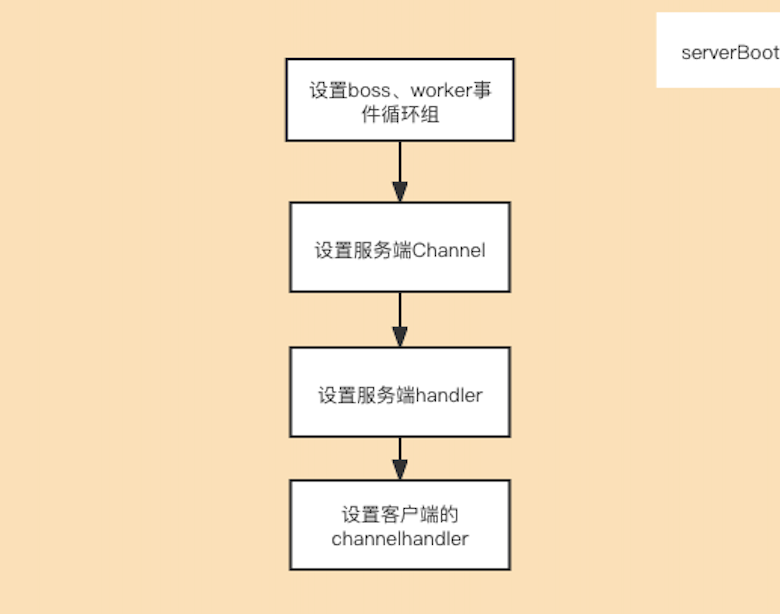
ServerBootstrap.bind
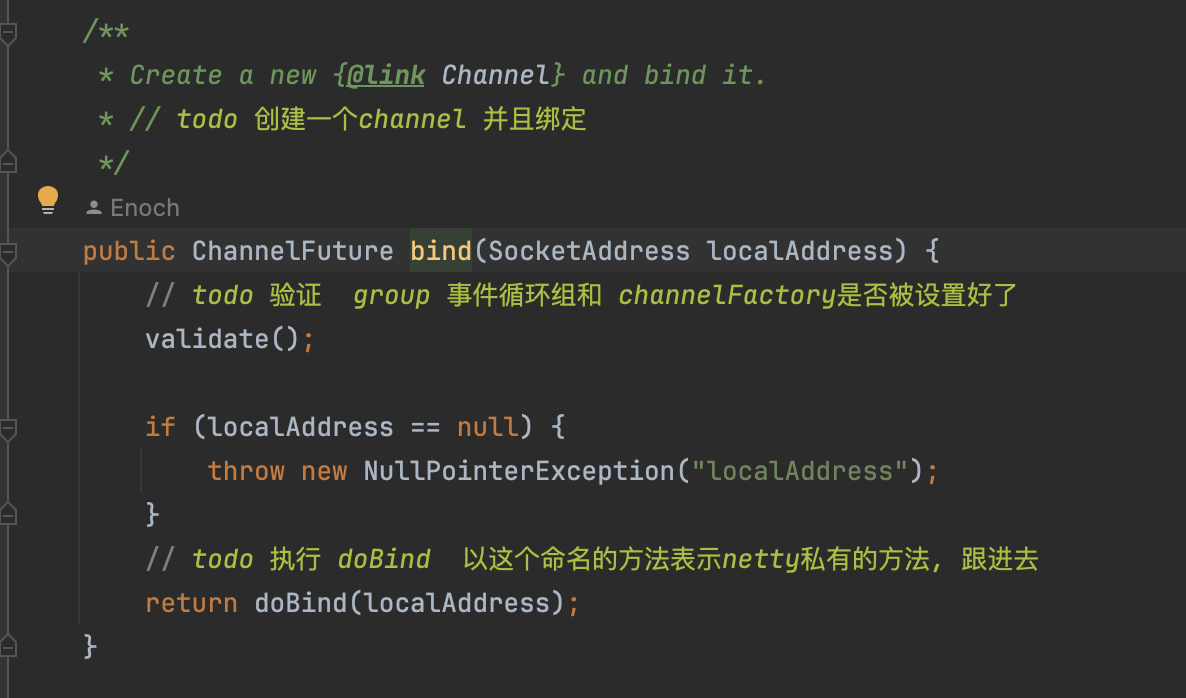
最终会调用到abstractBootstrap.doBind操作
AbstractBootstrap.doBind
private ChannelFuture doBind(final SocketAddress localAddress) {
// todo 初始化 和 注册 带 Future 字眼的表示异步!!! 它本身返回的就是一个ChannelFuture
final ChannelFuture regFuture = initAndRegister();
final Channel channel = regFuture.channel();
if (regFuture.cause() != null) {
return regFuture;
}
if (regFuture.isDone()) {
// At this point we know that the registration was complete and successful.
ChannelPromise promise = channel.newPromise();
// TODO 继续绑定端口 doBind0
doBind0(regFuture, channel, localAddress, promise);
return promise;
} else {
// Registration future is almost always fulfilled already, but just in case it's not.
final PendingRegistrationPromise promise = new PendingRegistrationPromise(channel);
regFuture.addListener(new ChannelFutureListener() {
@Override
public void operationComplete(ChannelFuture future) throws Exception {
Throwable cause = future.cause();
if (cause != null) {
// Registration on the EventLoop failed so fail the ChannelPromise directly to not cause an
// IllegalStateException once we try to access the EventLoop of the Channel.
promise.setFailure(cause);
} else {
// Registration was successful, so set the correct executor to use.
// See https://github.com/netty/netty/issues/2586
promise.registered();
doBind0(regFuture, channel, localAddress, promise);
}
}
});
return promise;
}
}
�先看initAndRegister方法
final ChannelFuture initAndRegister() {
Channel channel = null;
try {
// todo 这个 channelFactory是那个 反射工厂ReflectiveChannelFactory 对服务端来说, 可以创建 NioServerSocketChannel 对象
// todo 而这个对象又是 Selector的一种实现 就是SelectorProvider.providor()方法
// todo 实例化 NioServerSocketChannel, 通过反射走的是无参的构造, 我们去追踪它的无参构造去
channel = channelFactory.newChannel();
// todo 初始化Channel, 好几轮赋值, 以及添加 handler 等组件
init(channel);
} catch (Throwable t) {
if (channel != null) {
// channel can be null if newChannel crashed (eg SocketException("too many open files"))
channel.unsafe().closeForcibly();
}
// as the Channel is not registered yet we need to force the usage of the GlobalEventExecutor
return new DefaultChannelPromise(channel, GlobalEventExecutor.INSTANCE).setFailure(t);
}
// todo 注册 group == BOSS EventLoopGroup , -- > 暂时以为, 他是想确保把通过反射创建出来的NioServerSocketChannel注册进 BossGroup
// todo 目的是,让通过这个NioServerSocketChannel中的ServerSocketChannel 去 accept客户端的连接, 进而把连接通过Acceptor 扔给 WorkerGroup
// todo config()--> ServerBootstrapConfig
// todo group()--> NioEventLoopGroup -- workerGroup
// todo 我们用户点进去 进入 EventLoopGroup. 而 Debug 进入的是 MultithreadEventLoopGroup类 , 因为我这里的是 NioEventLoopGroup 是 MultithreadEventLoopGroup类的子类
// todo !!! 忽略的一个重点, group是 MultithreadEventLoopGroup类 我们知道这个类中维护的是 BossGroup, 即将channel注册进bossgroup中
ChannelFuture regFuture = config().group().register(channel);
if (regFuture.cause() != null) { // todo 非空表示注册失败了
if (channel.isRegistered()) {
channel.close();
} else {
channel.unsafe().closeForcibly();
}
}
// If we are here and the promise is not failed, it's one of the following cases:
// todo 如果我们期待的结果并没有失败, 就会出现下面几种情况
// 1) If we attempted registration from the event loop, the registration has been completed at this point.
// i.e. It's safe to attempt bind() or connect() now because the channel has been registered.
// todo 如果我们 企图往事件循环中注册通道, 因为现在这个通道晶注册完毕了,所以 bind() 和 connet()是安全的
// 2) If we attempted registration from the other thread, the registration request has been successfully
// added to the event loop's task queue for later execution.
// i.e. It's safe to attempt bind() or connect() now:
// because bind() or connect() will be executed *after* the scheduled registration task is executed
// because register(), bind(), and connect() are all bound to the same thread.
return regFuture;
}
channelFactory.newChannel(反射创建channel)
channelFactory.newChannel() 会最终调用到 外面配置的�NioServerSocketChannel.newInstance,也就是最终会走到它的构造方法
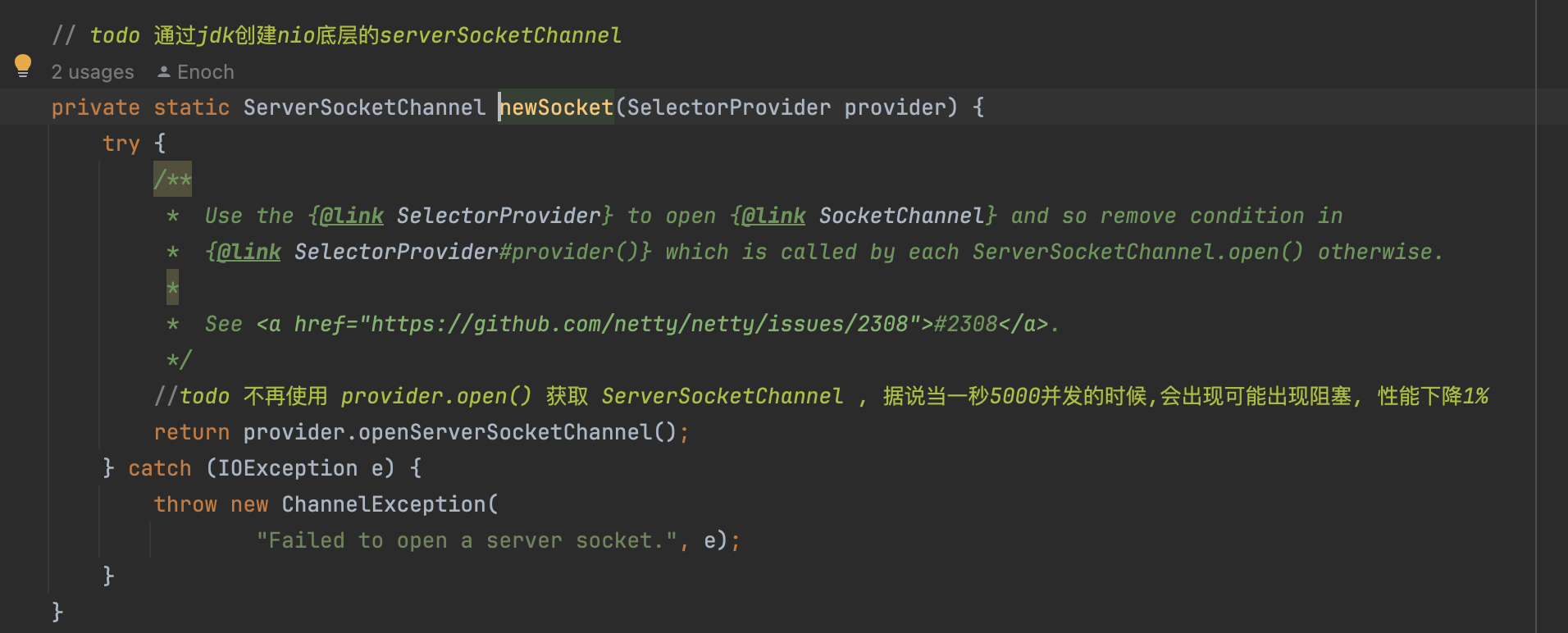
记住jdk的是 serverSocketChannel,接下来是调用带ServerSocketChannel的构造方法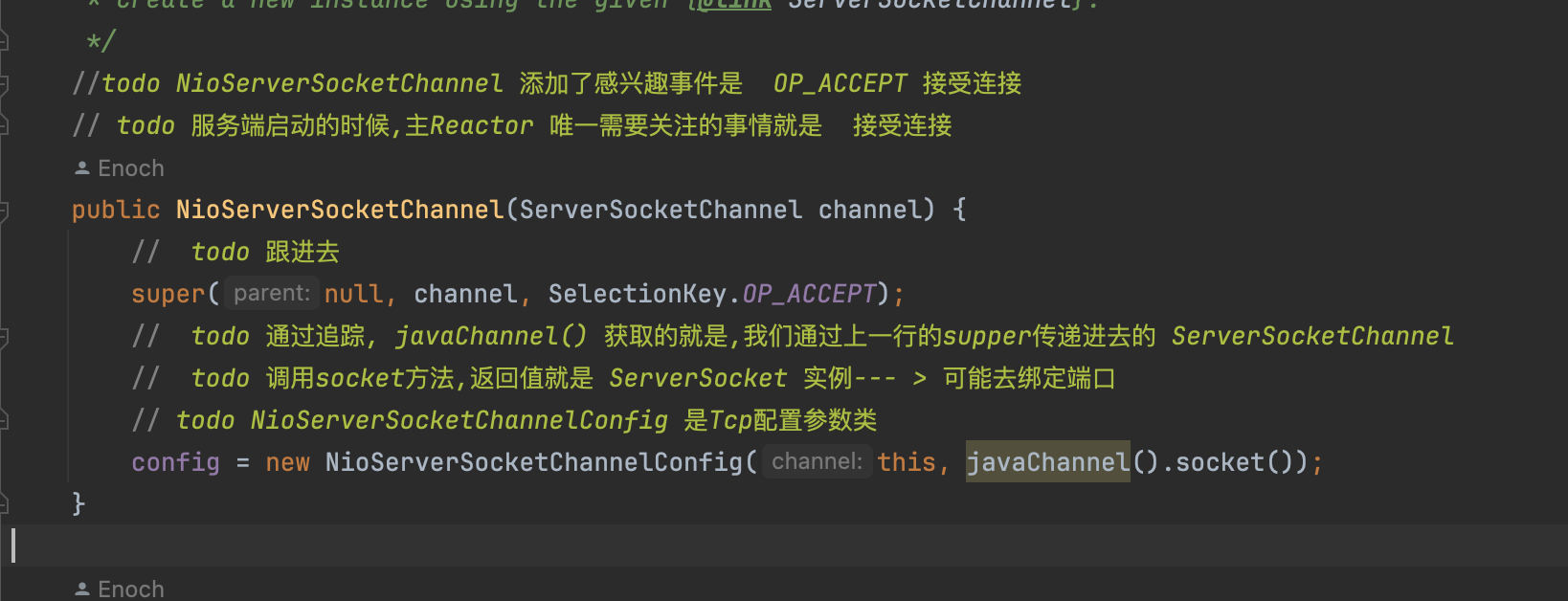
super()一路最终调用AbstractNioChannel的构造方法,下面就是创建了一个NioServerSocketChannelConfig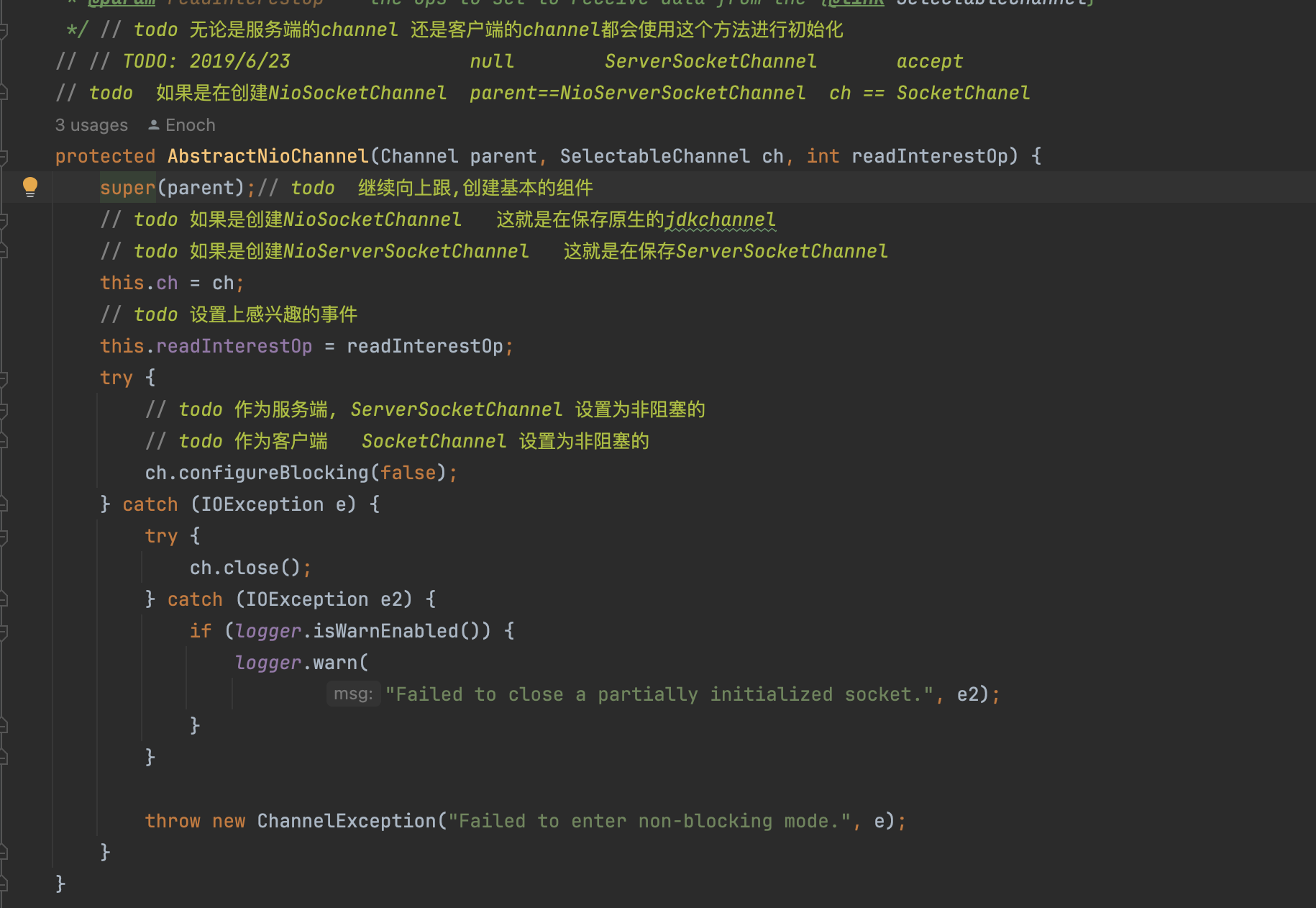
这里AbstractNioChannel的构造方法里面做了几件事:
- 继续调用super,调用到AbstractChannel的构造方法,里面设置channelId、创建NioMessageUnsafe对象、创建Pipline对象
- 保存传入进来的jdk原生的ServerSocketChannel
- 设置上感兴趣的事件
- 设置非阻塞
最后用一张图总结一下: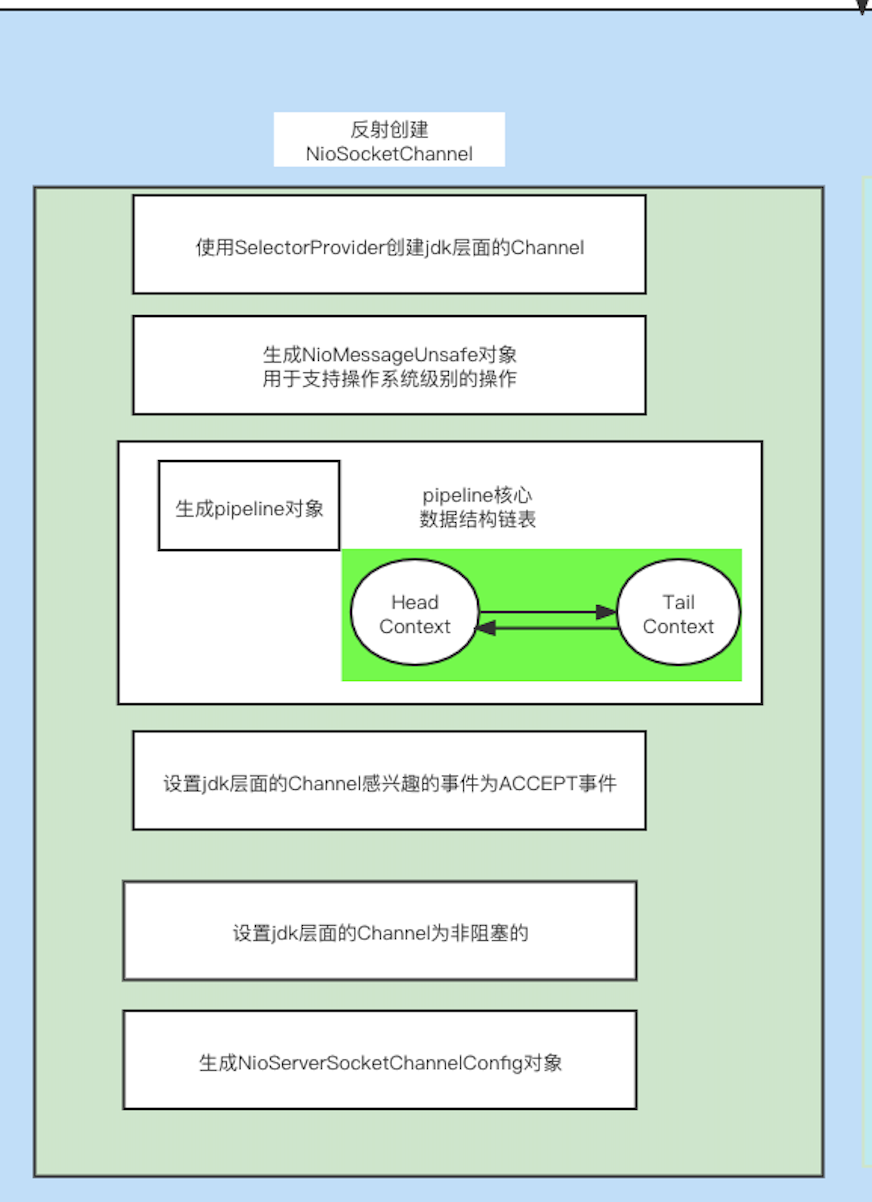
init(channel):初始化channel
@Override
void init(Channel channel) throws Exception {
// todo ChannelOption 是在配置 Channel 的 ChannelConfig 的信息
final Map<ChannelOption<?>, Object> options = options0();
synchronized (options) {
// todo 把 NioserverSocketChannel 和 options Map传递进去, 给Channel里面的属性赋值
// todo 这些常量值全是关于和诸如TCP协议相关的信息
setChannelOptions(channel, options, logger);
}
// todo 再次一波 给Channel里面的属性赋值 attrs0()是获取到用户自定义的业务逻辑属性 -- AttributeKey
final Map<AttributeKey<?>, Object> attrs = attrs0();
// todo 这个map中维护的是 程序运行时的 动态的 业务数据 , 可以实现让业务数据随着netty的运行原来存进去的数据还能取出来
synchronized (attrs) {
for (Entry<AttributeKey<?>, Object> e : attrs.entrySet()) {
@SuppressWarnings("unchecked")
AttributeKey<Object> key = (AttributeKey<Object>) e.getKey();
channel.attr(key).set(e.getValue());
}
}
// todo------- options attrs : 都可以在创建BootStrap时动态的传递进去
// todo ChannelPipeline 本身 就是一个重要的组件, 他里面是一个一个的处理器, 说他是高级过滤器,交互的数据 会一层一层经过它
// todo 下面直接就调用了 p , 说明,在channel调用pipeline方法之前, pipeline已经被创建出来了!,
// todo 到底是什么时候创建出来的 ? 其实是在创建NioServerSocketChannel这个通道对象时,在他的顶级抽象父类(AbstractChannel)中创建了一个默认的pipeline对象
/// todo 补充: ChannelHandlerContext 是 ChannelHandler和Pipeline 交互的桥梁
ChannelPipeline p = channel.pipeline();
// todo workerGroup 处理IO线程
final EventLoopGroup currentChildGroup = childGroup;
// todo 我们自己添加的 Initializer
final ChannelHandler currentChildHandler = childHandler;
final Entry<ChannelOption<?>, Object>[] currentChildOptions;
final Entry<AttributeKey<?>, Object>[] currentChildAttrs;
// todo 这里是我们在Server类中添加的一些针对新连接channel的属性设置, 这两者属性被acceptor使用到!!!
synchronized (childOptions) {
currentChildOptions = childOptions.entrySet().toArray(newOptionArray(childOptions.size()));
}
synchronized (childAttrs) {
currentChildAttrs = childAttrs.entrySet().toArray(newAttrArray(childAttrs.size()));
}
// todo 下面的代码中是Netty原生默认会往NioServerSocketChannel的管道里面添加了一个 ChannelInitializer ,
// todo 通过这个ChannelInitializer可以实现大批量的往 pipeline中添加处理器
// todo ( 后来我们自己添加的ChildHandler 就继承了的这个ChannelInitializer , 而这个就继承了的这个ChannelInitializer 实现了ChannelHandler)
p.addLast(new ChannelInitializer<Channel>() { // todo 进入addlast
// todo 这是个匿名内部类, 一旦new ,就去执行它的构造方法群, 完事后再回来看下面的代码,
// todo 这个ChannelInitializer 方便我们一次性往pipeline中添加多个处理器
@Override
public void initChannel(final Channel ch) throws Exception {
final ChannelPipeline pipeline = ch.pipeline();
// todo 获取Bootstrap的handler 对象, 没有则返回空
// todo 这个handler 针对BossGroup的Channel , 给他添加上我们在server类中添加的handler()里面添加处理器
ChannelHandler handler = config.handler();
if (handler != null) {
pipeline.addLast(handler);
}
// todo ServerBootstrapAcceptor 接收器, 是一个特殊的chanelHandler
ch.eventLoop().execute(new Runnable() {
@Override
public void run() {
// todo !!! -- 这个很重要,在ServerBootStrap里面,netty已经为我们生成了接收器 --!!!
// todo 专门处理新连接的接入, 把新连接的channel绑定在 workerGroup中的某一条线程上
// todo 用于处理用户的请求, 但是还有没搞明白它是怎么触发执行的
pipeline.addLast(new ServerBootstrapAcceptor(
// todo 这些参数是用户自定义的参数
// todo NioServerSocketChannel, worker线程组 处理器 关系的事件
ch, currentChildGroup, currentChildHandler, currentChildOptions, currentChildAttrs));
}
});
}
});
System.out.println("哈哈哈哈.....");
}
�代码看着一大堆,其实就做了几件事:
- 将ServerBootStrap配置上的参数应用到channel上
- 然后在channel的pipline的链表上增加了一个ChannelInitializer
- 但是这个时候其实是没有执行ChannelInitializer里面的方法的
具体流程如图所示: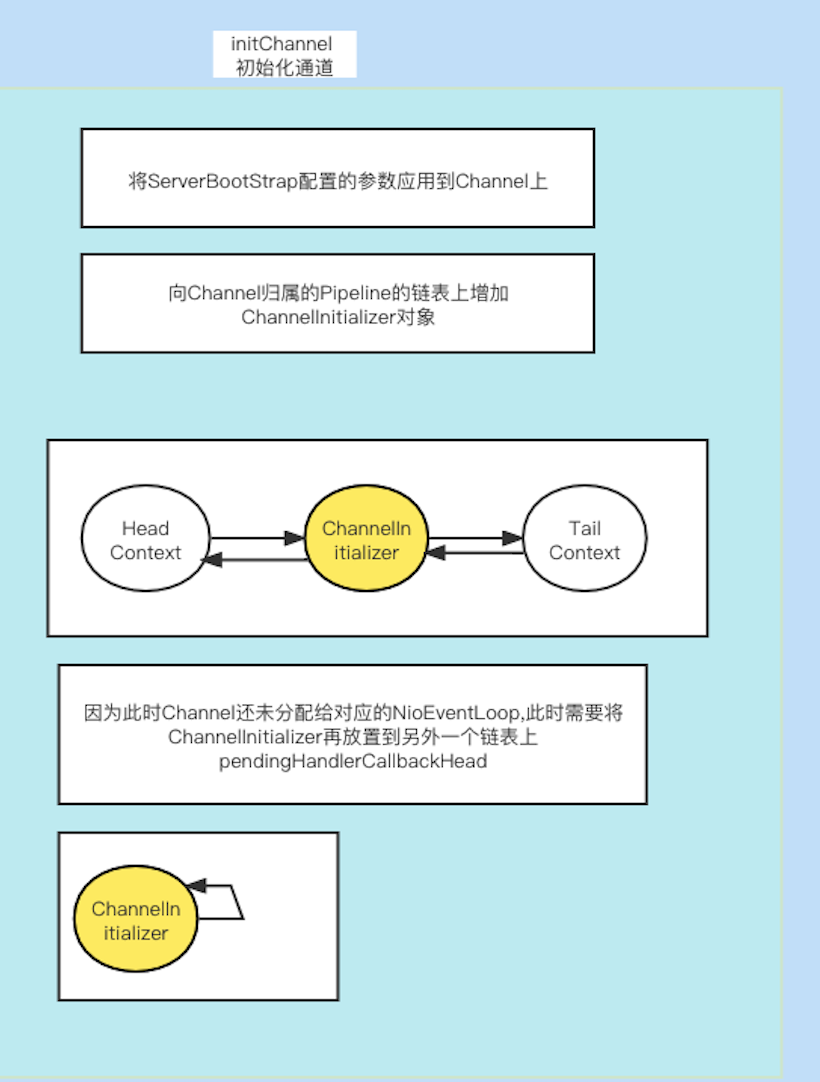
�
�
EventLoopGroup.register(channel):
由于EventLoopGroup是继承MutithreadEventLoopGroup,最终会调用到它
�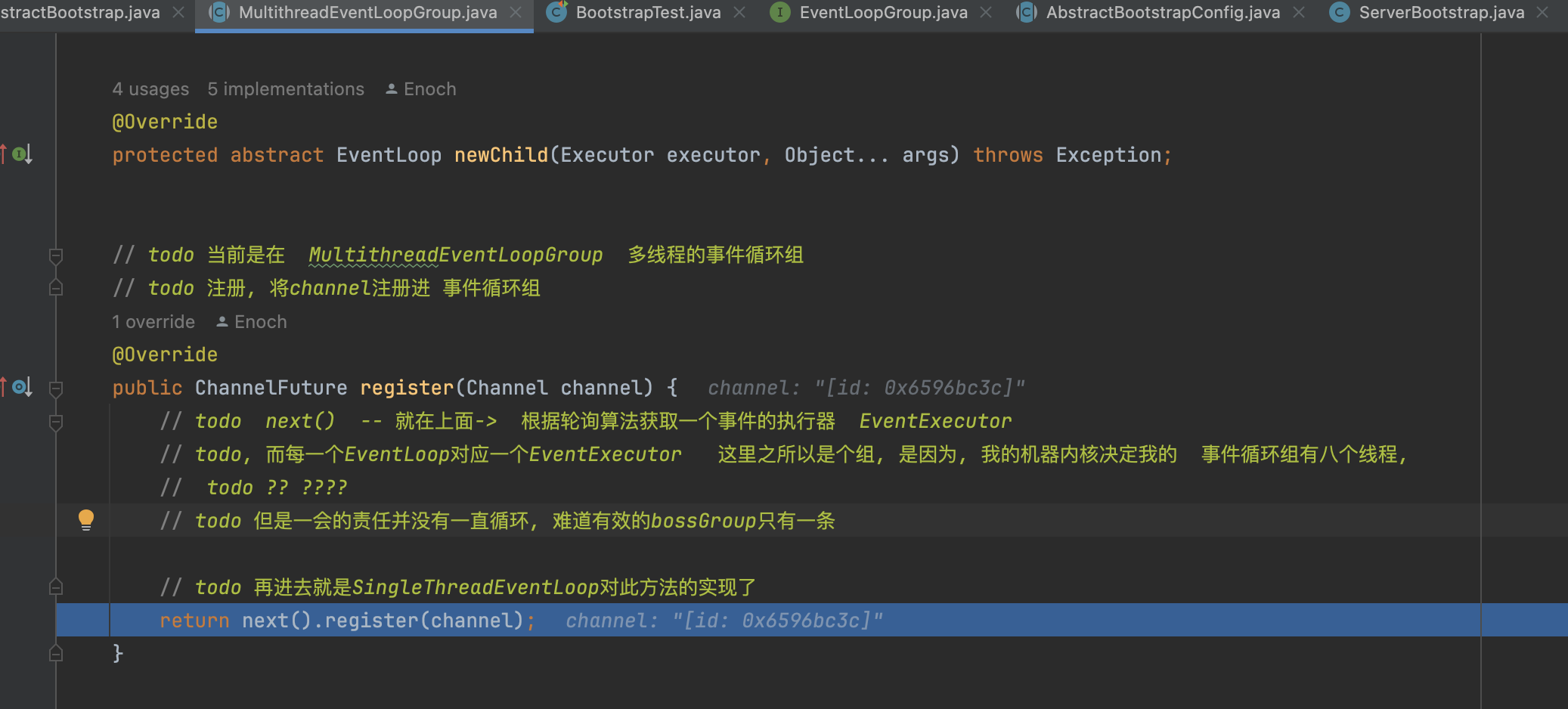
这里的next(一组EventLoopGroup里面有很多EventLoop,使用轮训算法给你找一个EventLoop)返回的是NioEventLoop: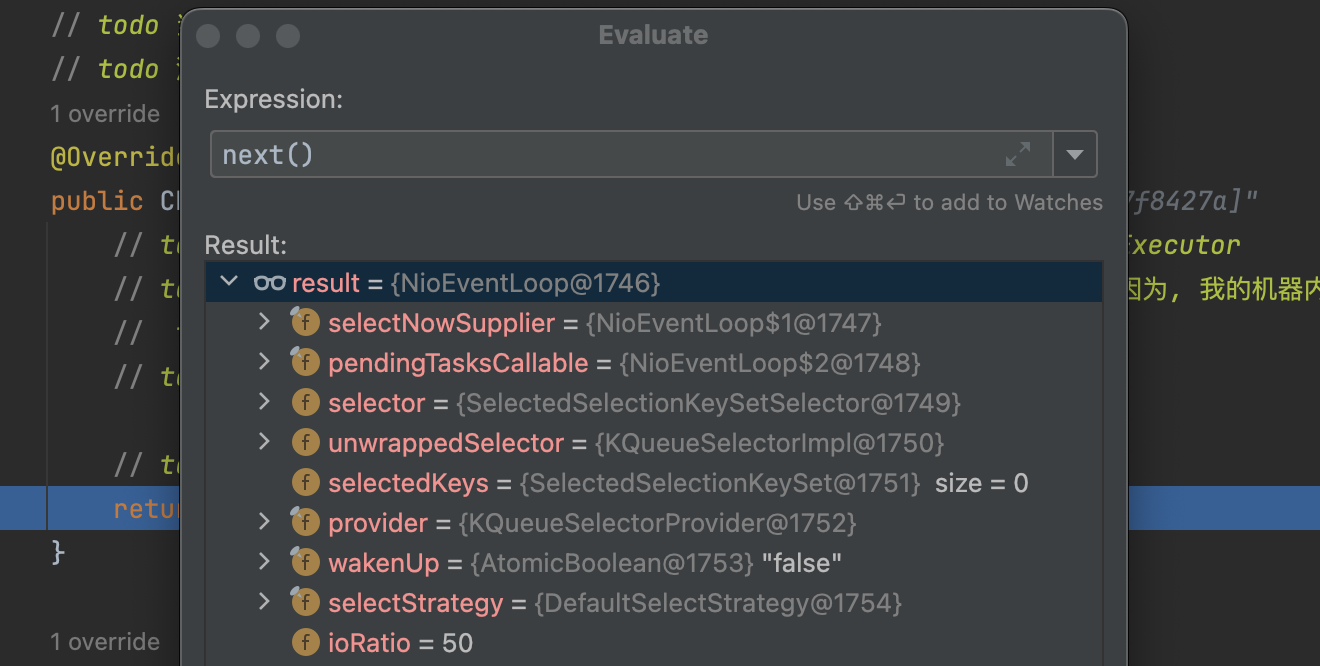
由于EventLoop继承的是SingleThreadEventLoop,最终调用到它的register方法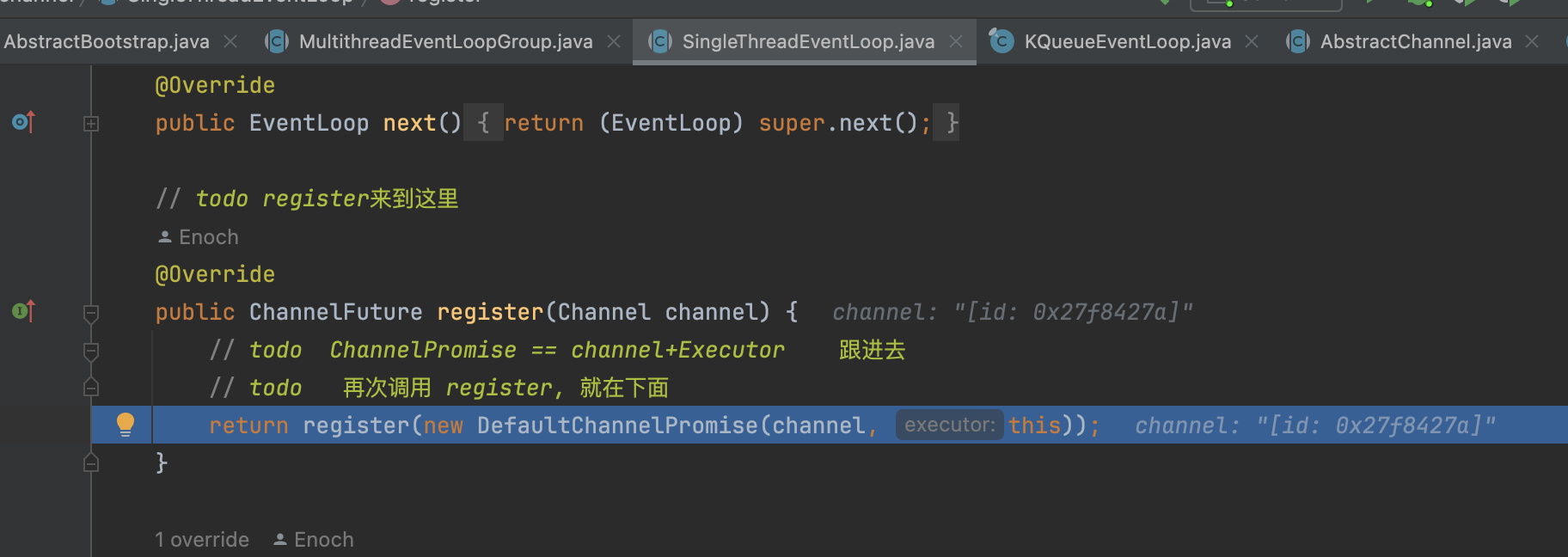

最终会调用AbstractChannel.register方法
@Override
// todo 入参 eventLoop == SingleThreadEventLoop promise == NioServerSocketChannel + Executor
public final void register(EventLoop eventLoop, final ChannelPromise promise) {
if (eventLoop == null) {
throw new NullPointerException("eventLoop");
}
if (isRegistered()) {
promise.setFailure(new IllegalStateException("registered to an event loop already"));
return;
}
if (!isCompatible(eventLoop)) {
promise.setFailure(
new IllegalStateException("incompatible event loop type: " + eventLoop.getClass().getName()));
return;
}
// todo 赋值给自己的 事件循环, 把当前的eventLoop赋值给当前的Channel上 作用是标记后续的所有注册的操作都得交给我这个eventLoop处理, 正好对应着下面的判断
// todo 保证了 即便是在多线程的环境下一条channel 也只能注册关联上唯一的eventLoop,唯一的线程
AbstractChannel.this.eventLoop = eventLoop;
// todo 下面的分支判断里面执行的代码是一样的!!, 为什么? 这是netty的重点, 它大量的使用线程, 线程之间就会产生同步和并发的问题
// todo 下面的分支,目的就是把线程可能带来的问题降到最低限度
// todo 进入inEventLoop() --> 判断当前执行这行代码的线程是否就是 SingleThreadEventExecutor里面维护的那条唯一的线程
// todo 解释下面分支的必要性, 一个eventLoop可以注册多个channel, 但是channel的整个生命周期中所有的IO事件,仅仅和它关联上的thread有关系
// todo 而且,一个eventLoop在他的整个生命周期中,只和唯一的线程进行绑定,
//
// todo 当我们注册channel的时候就得确保给他专属它的thread,
// todo 如果是新的连接到了,
if (eventLoop.inEventLoop()) {
// todo 进入regist0()
register0(promise);
} else {
try {
// todo 如果不是,它以一个任务的形式提交 事件循环 , 新的任务在新的线程开始, 规避了多线程的并发
// todo 他是SimpleThreadEventExucutor中execute()实现的,把任务添加到执行队列执行
eventLoop.execute(new Runnable() {
@Override
public void run() {
register0(promise);
}
});
} catch (Throwable t) {
logger.warn(
"Force-closing a channel whose registration task was not accepted by an event loop: {}",
AbstractChannel.this, t);
closeForcibly();
closeFuture.setClosed();
safeSetFailure(promise, t);
}
}
}
�总结一下一共做了几件事:
- 将EventLoop赋值给channel
- 判断执行当前代码是不是EventLoop里面那个唯一线程在执行,如果是由它在执行,那就直接执行register0,如果不是就创建一个任务然后 eventLoop.execute执行, 由于EventLoop继承了SingleThreadEventExecutor,最终会调用到SingleThreadEventExecutor.execute方法
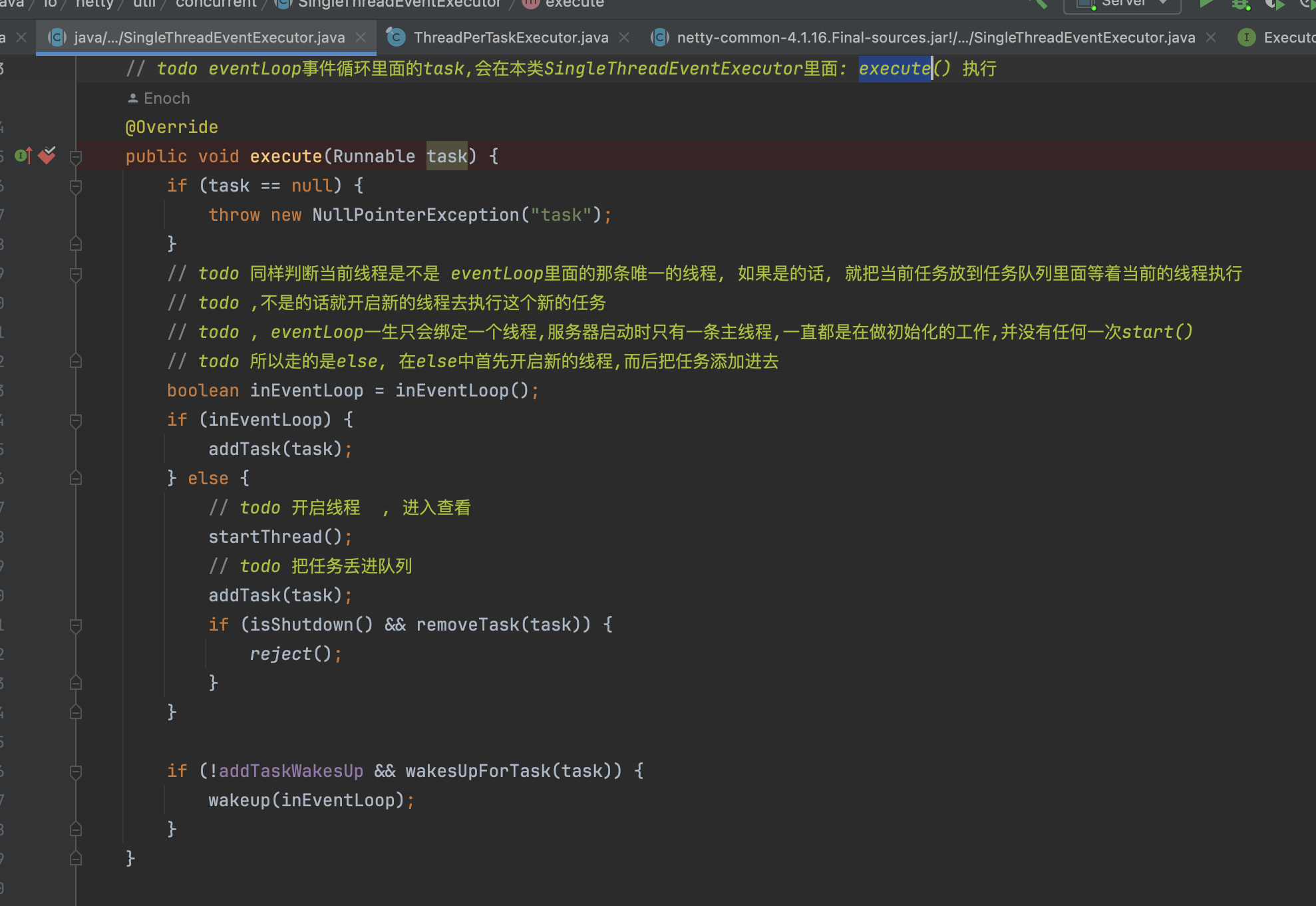

这个executor.execute具体如下: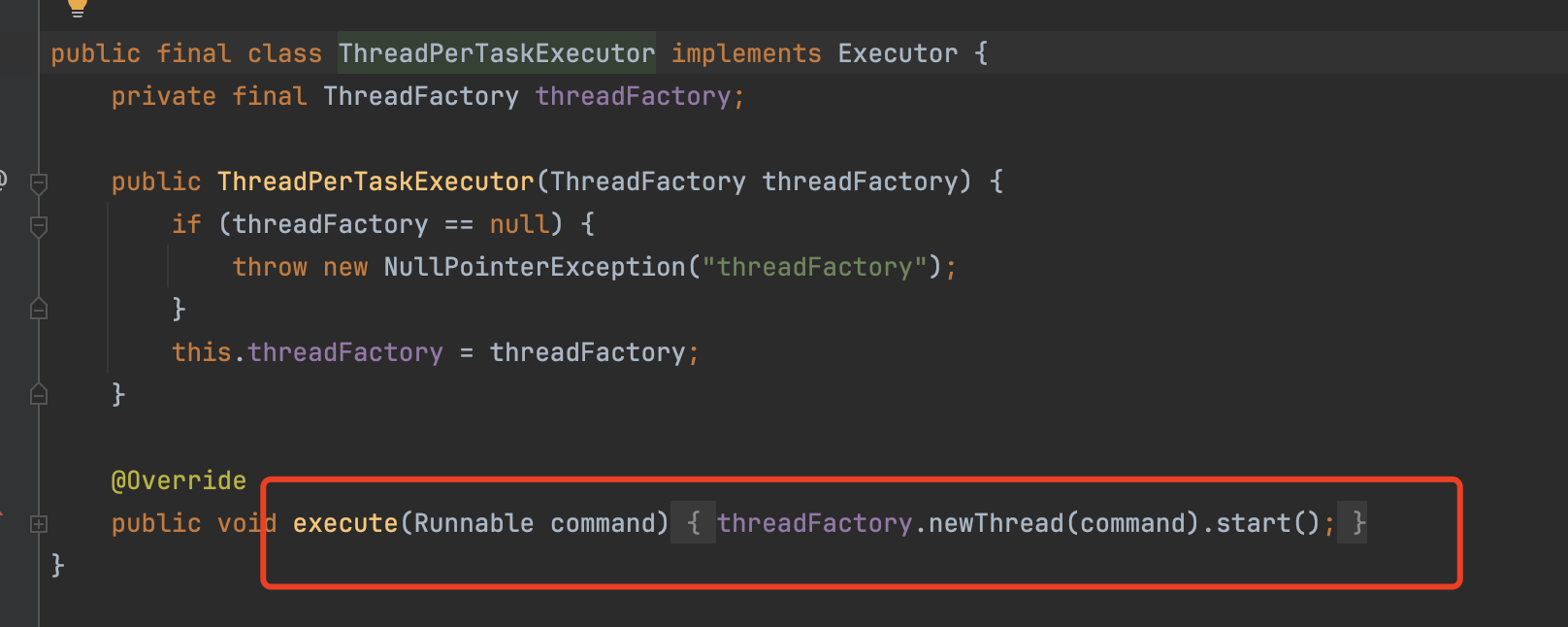
结合上面所有的内容总结:
- 利用ThreadPerTaskExecutor创建了一个线程,并启动
- 这个线程执行的是SingleThreadEventExecutor.this.run(); 最终又会跑到执行 NioEventLoop的run方法,如图所示:
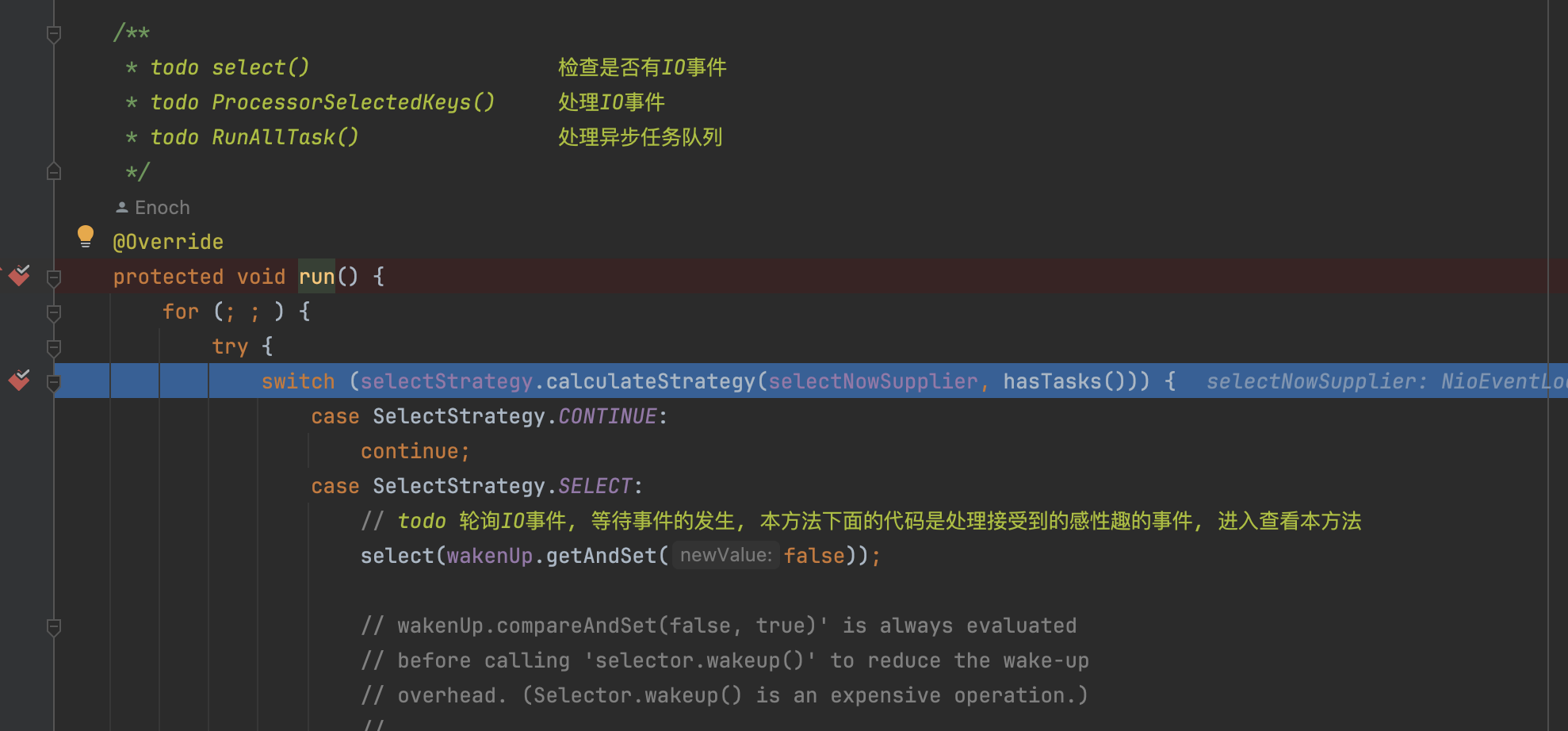
- 上面其实就是创建了一个线程,然后不断的执行NioEventLoop的run方法
- 将传进来的task放到队列中,有点类似于线程池的设计,后续这个NioEventLoop会从对列中取出任务执行
这个流程如图所示:
NioEventLoop.run (类似于线程池)
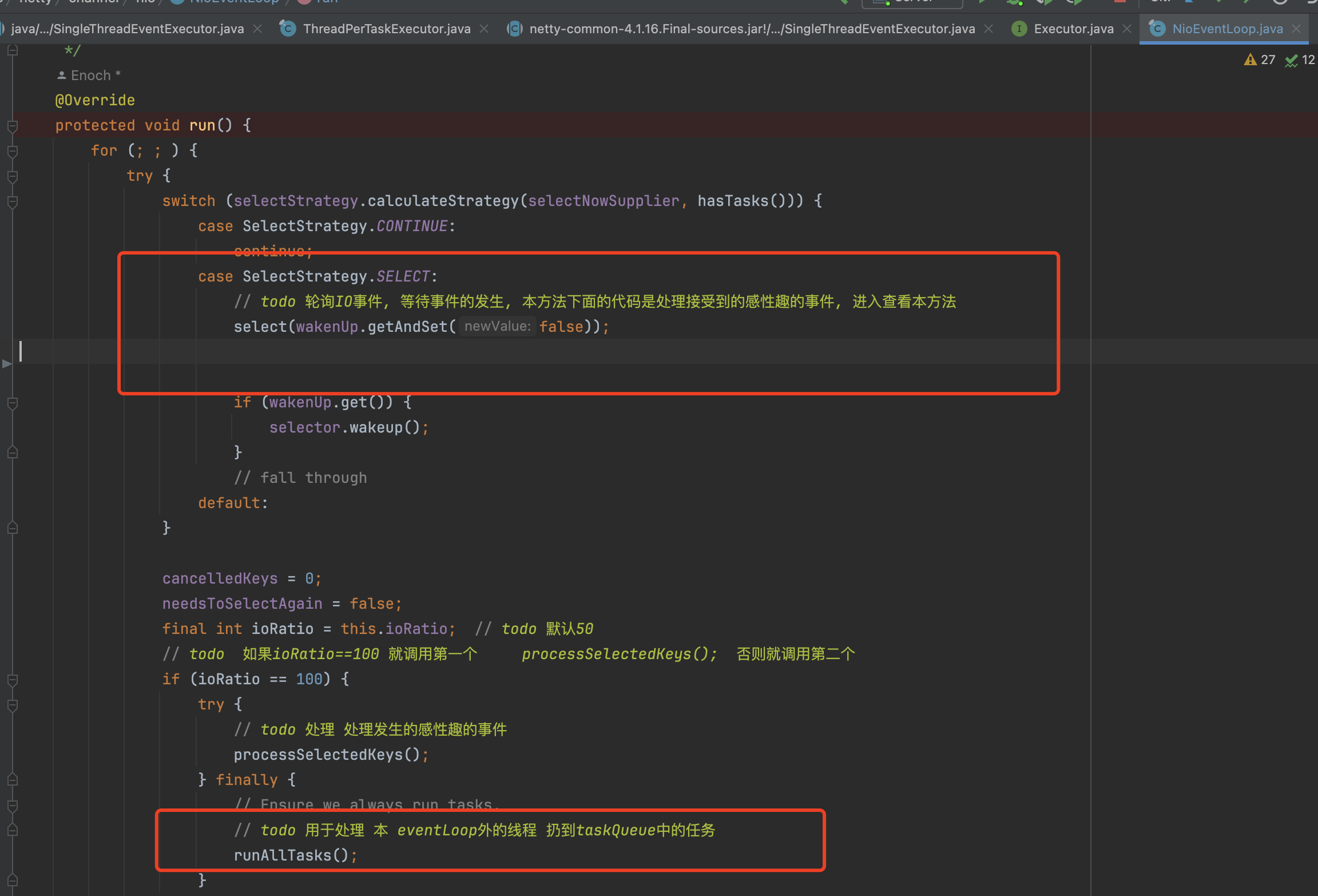
它不断的run,最终会执行到我们往里面提交的register0方法,我们来看register0方法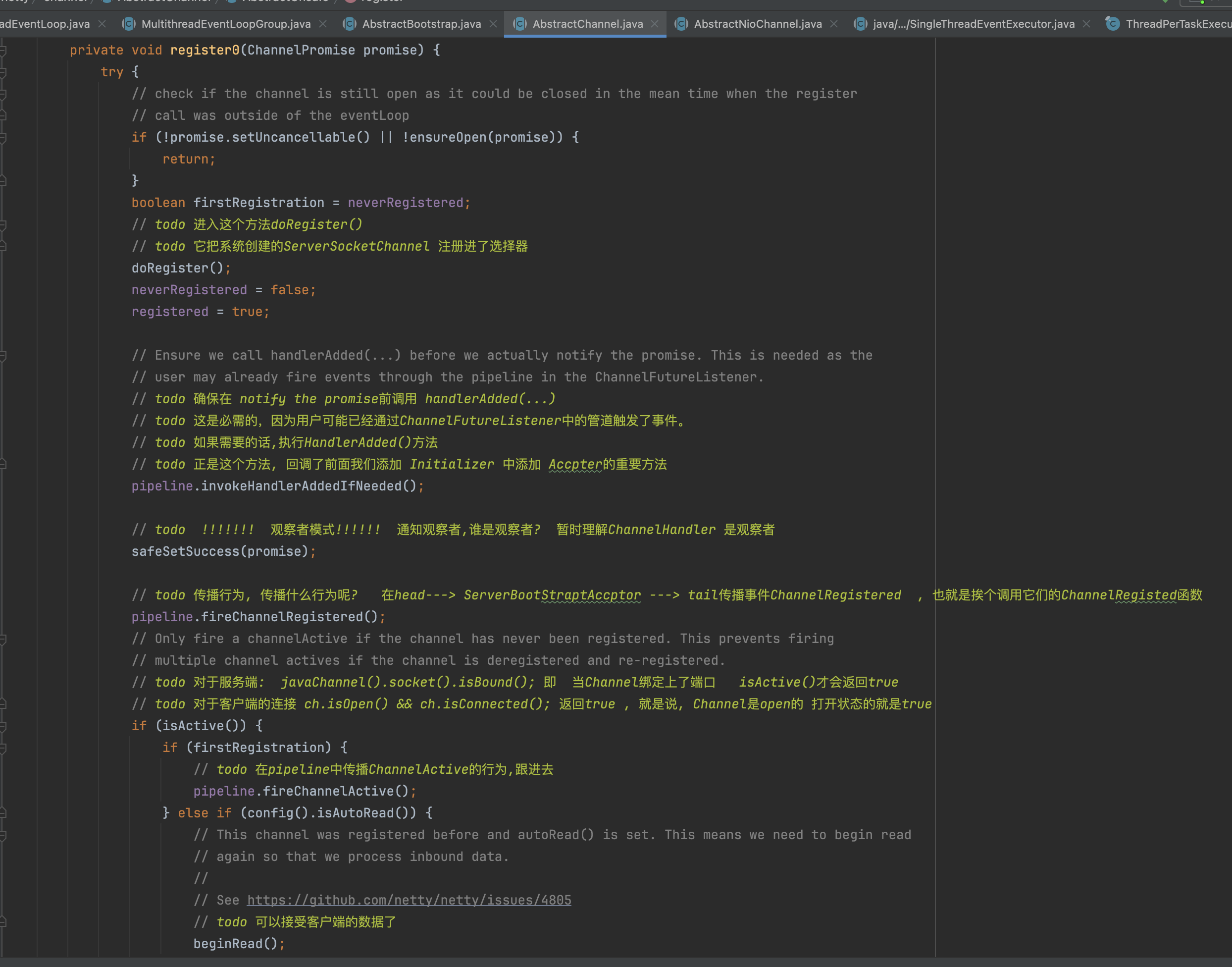
具体做了几件事:
- 向Selector注册上Jdk层面上的channel:doRegister
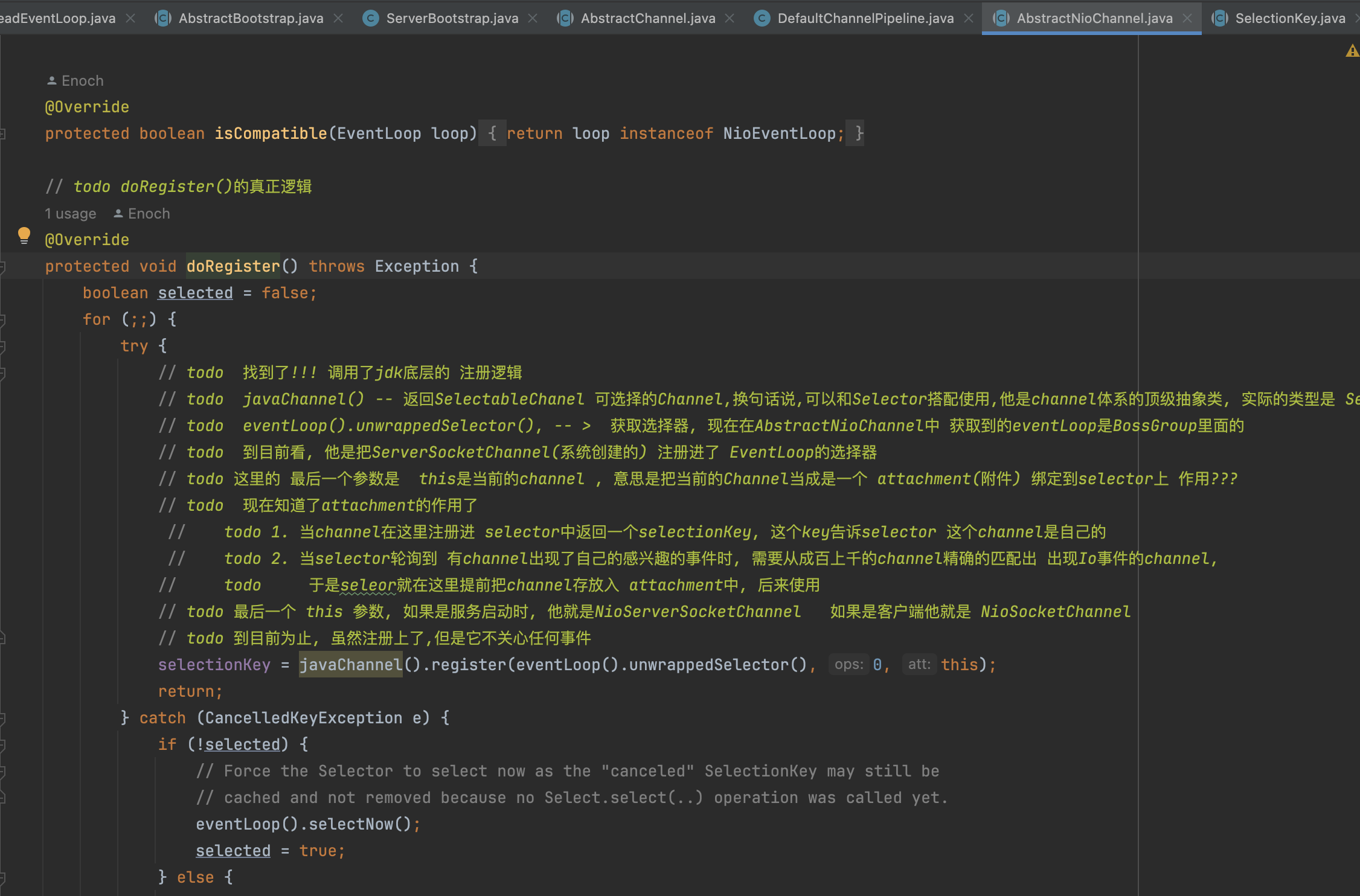
- 回调触发之前配置的childHandler:
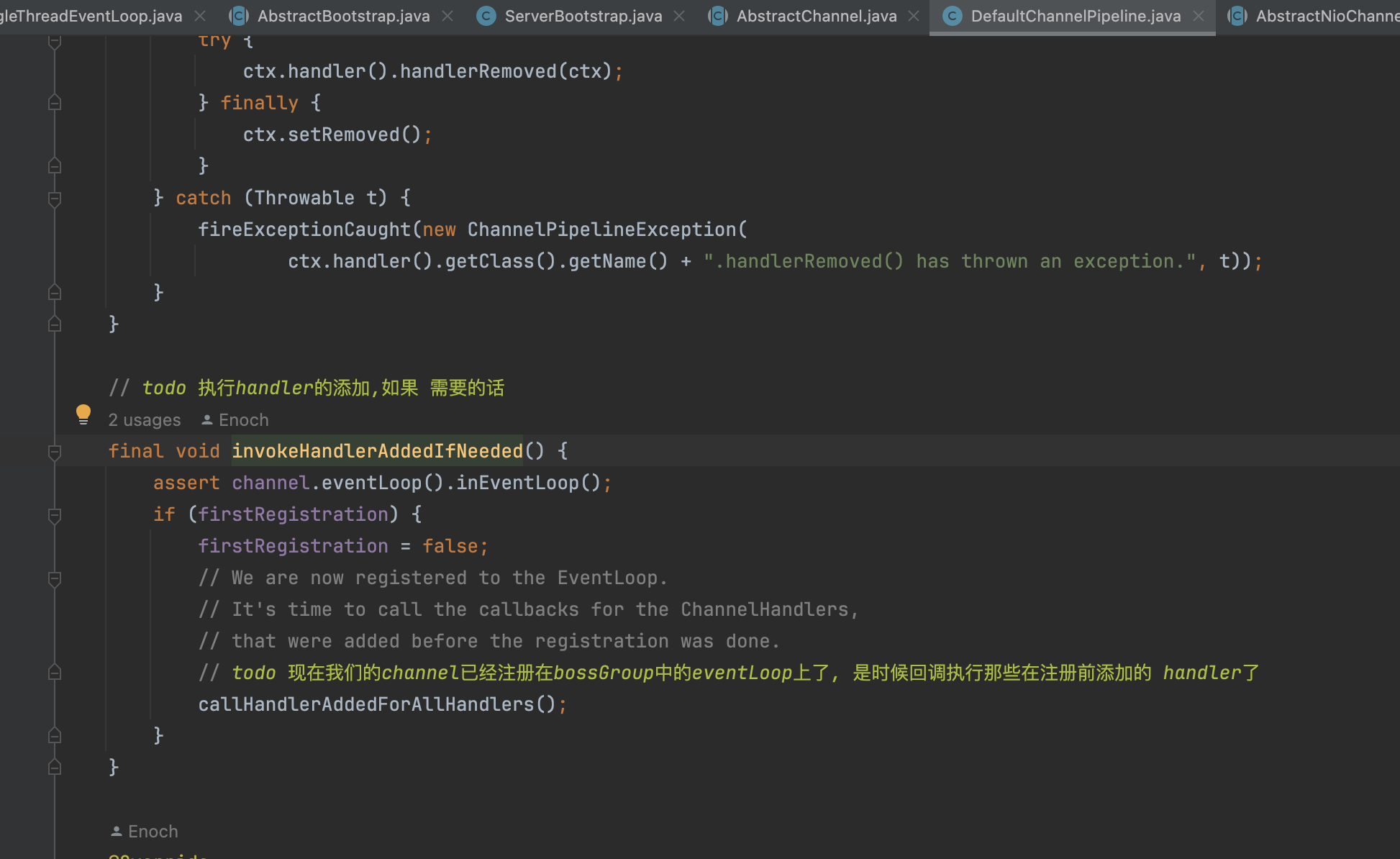
回调我们之前设置的Channelnitializer: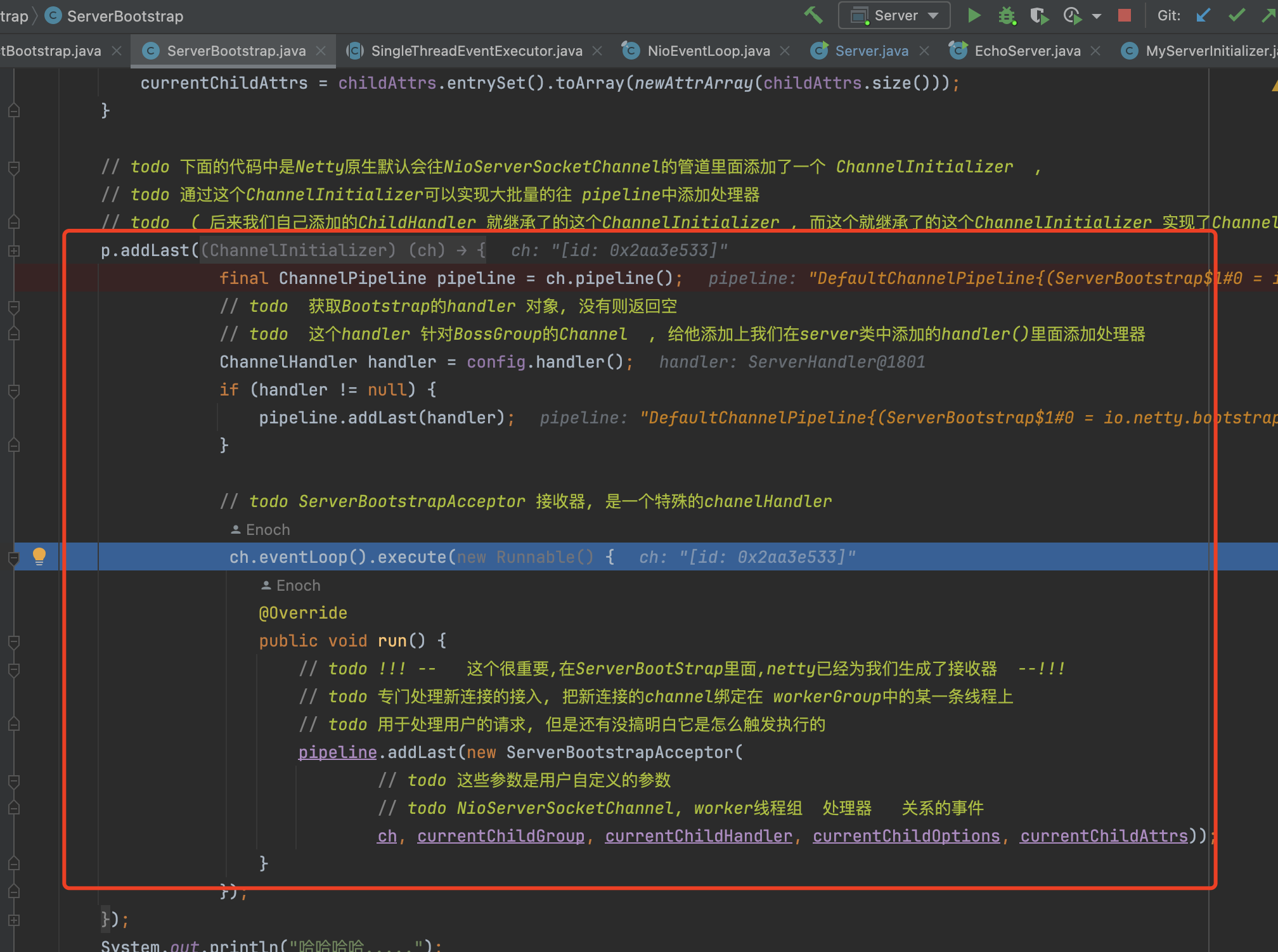
如果说我们配置了 ,在这一步会加入到Pipline中,具体长这样:
,在这一步会加入到Pipline中,具体长这样: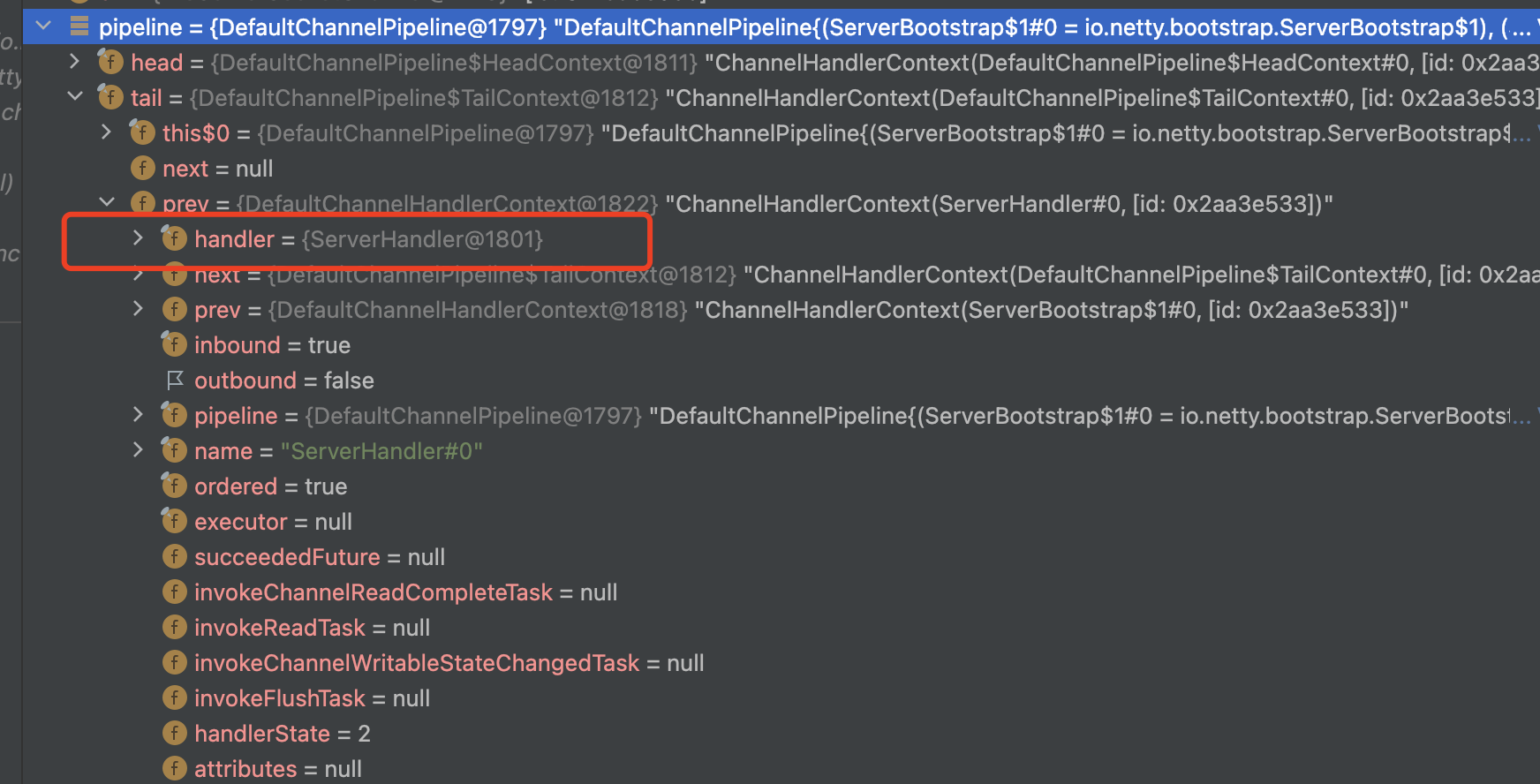
接下来 又往NioEventLoop中提交了一个任务,
又往NioEventLoop中提交了一个任务,
完整的流程图如下: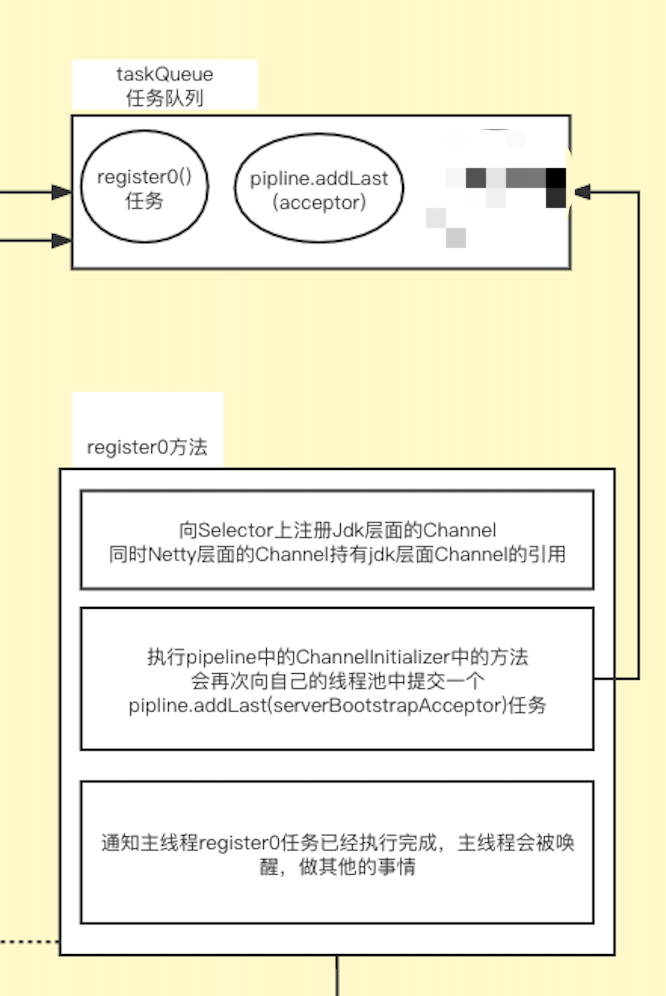
- 通知主线程register0已经完成,主线程会被唤醒做其他事
doBind0: 绑定端口

这个比较简单,往NioEventLoop 提交一个 channel.bind的task
最终会调用到AbstractChannel.bind方法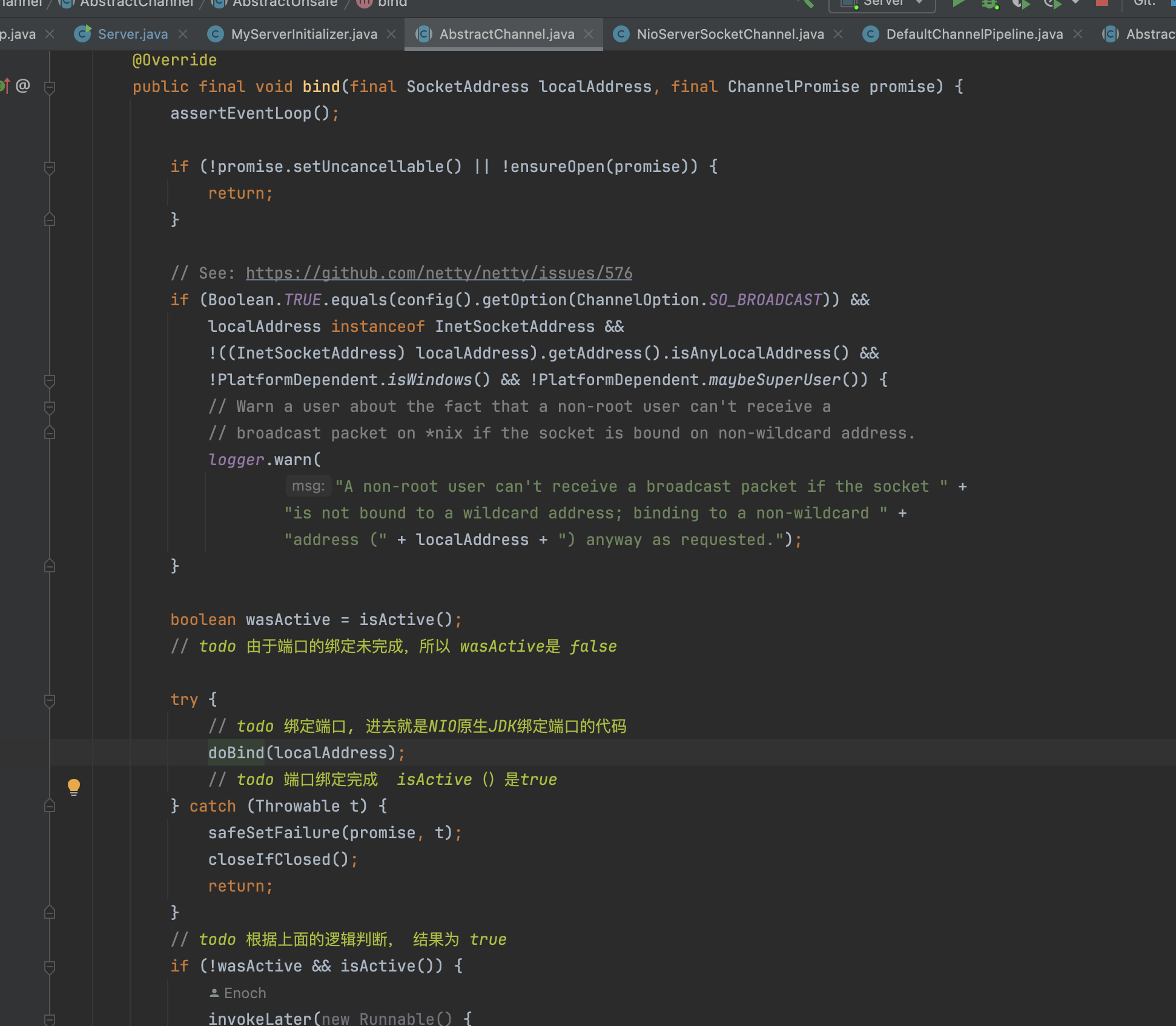
这里主要做了几件事:
- 使用nio原生Jdk绑定端口
- pipeline.fireChannelActive 会传播事件,它会触发channel的read,最终为已经注册到select的channel绑定感兴趣的Accept事件
- 唤醒主线程
doBind0完整的流程图如下: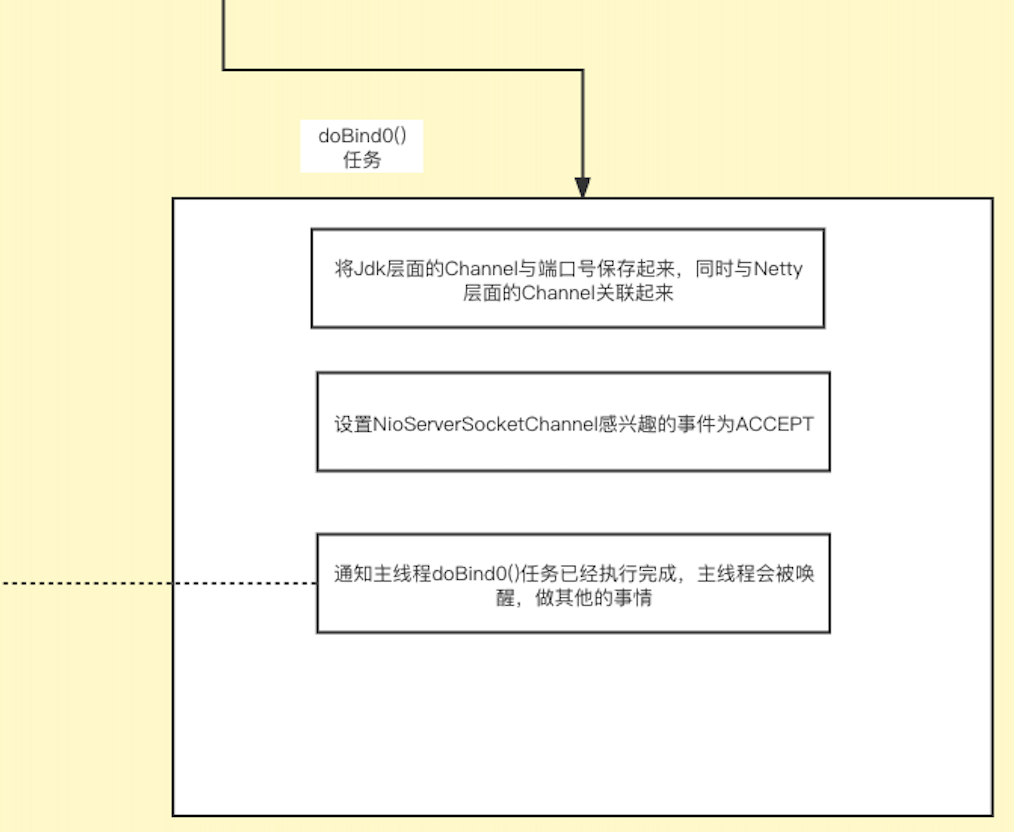
完整的启动图
